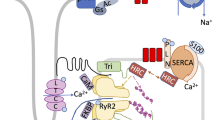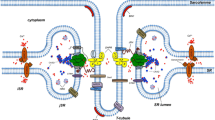Abstract
The uptake of calcium into the sarcoplasmic reticulum (SR) and its subsequent release from the SR play a key role in the regulation of the cytosolic calcium concentration and the excitation-contraction coupling in cardiac muscle. While calcium uptake, catalyzed by the calcium-dependent ATPase, is thought to occur throughout the SR, the release of calcium is controlled by a complex of proteins localized to a distinct region, the junctional SR. This complex consists of the calcium release channel or ryanodine receptor (RyR), the high capacity calcium-binding protein calsequestrin located in the lumen of the junctional SR, and the junctional SR transmembrane proteins triadin 1 and junctin which are hypothesized to anchor calsequestrin to the RyR.
Transgenic mice with cardiac-specific overexpression of triadin1 or junctin show distinct cardiac phenotypes with altered cellular and subcellular morphology, changes in contractile properties and/or in the expression of junctional SR proteins suggesting that these junctional sarcoplasmic reticulum transmembrane proteins are of functional relevance for the regulation of calcium release in the heart.
Similar content being viewed by others
Author information
Authors and Affiliations
Rights and permissions
About this article
Cite this article
Müller, F., Kirchhefer, U., Begrow, F. et al. Junctional sarcoplasmic reticulum transmembrane proteins in the heart. Basic Res Cardiol 97 (Suppl 1), I52–I55 (2002). https://doi.org/10.1007/s003950200030
Issue Date:
DOI: https://doi.org/10.1007/s003950200030




